The First Russian Battlecruisers
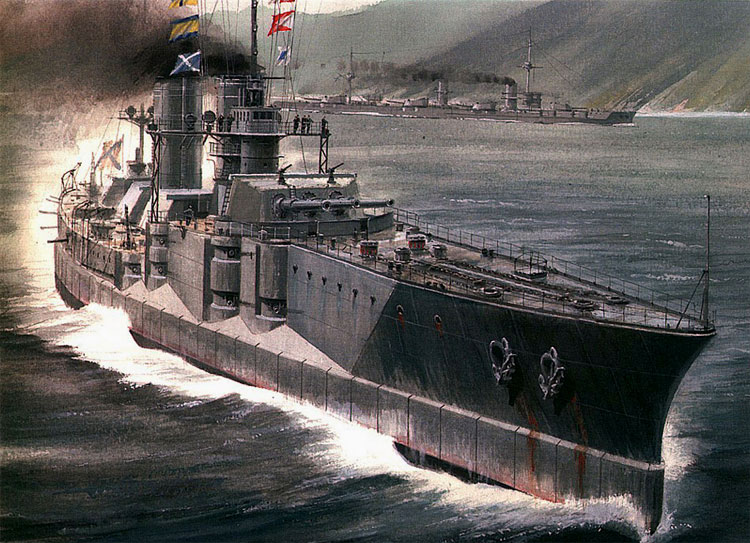
Artistic rendition of the Borodino, if completed.
Among the various capital ships planned by the Russian admiralty during WW1, the Borodino class were certainly among the most impressive. They reached a stage well beyond paper stage: They were actually launched in 1915-16, but all work was suspended in early 1917, and by October, ceased completely due to the revolution and subsequent civil war and later broke up for spare metal in 1922. That was the fate of many other ships started too late, like the Svetlana class cruisers (completed in the 1920s), Nakhimov class (two completed out of four), or the battleship Imperator Nikolai I. However, this should not prevent to study these unique attempts to contest the Baltic to the Kaiserliches Marine’s battlecruisers. They could have easily take on the latest Germany had to offer if completed in 1917, with quite a powerful armament, unrivalled at the time. The most advanced Izmail (which often gave its name to the class) was long considered by the Bolsheviks for completion, including an aircraft carrier, but nothing came out of it. All four battlecruisers were named after famous Russian naval battles.
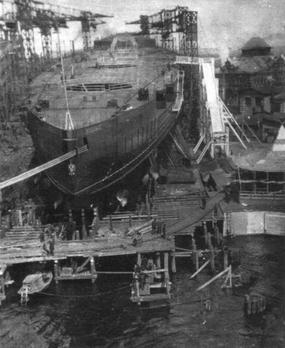
Izmail in construction in St Petersburg, 1915.
Design development
After the end of the Russo-Japanese War of 1905, the Russian Naval General Staff decided fast armoured cruisers were desirable, notably to do their own version Admiral Tōgō’s battleline done to them at Tsushima, crossing the T. The Naval Staff at first concentrated on high speed (28 knots) but above the average armoured cruiser with a main armament of 305 mm (12 in) guns. To save speed, protection was light, at best 190 mm (7.5 in) for the belt. The Tsar approved four of these on 5 May 1911. However the State Duma session ended before the vote was taken, and it was reported on 1912.
Meanwhile, preliminary bids were offered to private builders, both in Russia and foreign ones, but they were quite too optimistic and received no responses, leading the writing of more reasonable requirements. The Naval Staff issued this on 1st July 1911. Top speed was downgraded to 26.5 knots (49.1 km/h; 30.5 mph), but armour raised to 254 mm (10 in) in response. The more interesting aspects was the main, armament jumping to nine 356 mm (14 in) guns instead of 12-in, and in three deck-level triple turrets. This last one was due to incorrect intelligence that the Germans were choosing this caliber for their next battleships. The Russian Navy also justified the choice of widely separated turrets and magazines lowered the chance of a catastrophic ammunition explosion. This also allowed to make a lower profile, smaller target, and improving stability, thus, accuracy as well. The new design became in short an elongated Gangut with just one less turret and much more power output.
Proposals:
The Naval Ministry sent to 23 yard’s the last bid on 8 September 1911, but only 7 responded after an extra month. Several were rejected outright as not meeting the new specs, while new revisions were added by the Russian Artillery Section of the Main shipbuilding Administration. They settled indeed on a four-turret design. This revision was communicated in May 1912 to the seven bidders of the first round. The winner was the Admiralty Shipyard in Saint Petersburg. They sticked to the proven triple turret design, but managed to add one more, obtaining the same number of guns as the quadruple turret design, twelve.
Construction start
The Duma this time approved the construction of four ships based on this design in May 1912, with more facility as it was a domestic one. The design was finalised while 45.5 million rubles were allocated for each hull. The fourth gun turret however stretched the ships and tonnage, and they ended overbudget at 7 million rubles more for each, but to hide this, some of the budget was officially redirected for the Svetlana-class cruisers. Final Orders were placed on 18 September 1912. A pair of each one were laid down at the Admiralty Shipyard and to at the Baltic Works, all in Saint Petersburg. The first pair was launched and ready to start trials on 14 July 1916, and the second scheduled for 14 September 1916.
As named, these were the :
-Borodino (Admiralty Yard): 19/12/1913, launched 1.7.15
-Izmail (Baltic Yard): 19/12/1913, launched 27.6.15
-Kinburn (Baltic Yard): 19/12/1913, launched 30.10.15
-Navarin (Admiralty Yard): 19/12/1913, launched 9.11.16
1913 armour Trials
Full-scale armour trials that year revealed in between a great weakness in the protection scheme proposed, as showned by the modified old ironclad Chesma using the Gangut-class scheme, then under construction. The deck and turret roof were shown well too thin, and the side armour inner supporting structure too weak to withstand the impact of 12-in shells. Since this was the same scheme applied to the Borodinos, it was called for serious revision. This of course, slowed construction much, as the ships were intended to be launched earlier in 1915. Their deck armour was thickened by adding a sandwich of extra plates and the turret roofs thickened. The planned aft conning tower was deleted to save some weight while the main belt thickness was slightly lowered. Also the internal structure was revised, using mortise and tenon joints between the armour plates and their vertical edges. This was to lower the impact stress on the supporting internal griders and general hull structure. This was responsible of a six month delay, which basically doomed the completion of these ships because of events.
Detailed overview
The Borodino-class ships measured 223.85 metres (734 ft 5 in) long overall, to compare to the 188 m of the battleship Nikolai I in construction. Their beam reached 30.5 metres (100 ft 1 in), more than 2.5 m more than the latter, so not that favourable ratio, and a draft of 8.81 metres (28 ft 11 in) fully laden. Also to improve stability, they were fitted with three Frahm anti-rolling tanks on each side. Displacement reached 32,500 long tons (33,000 t) at normal jauge, 36,646 long tons (37,234 t) fully laden, which was 6,000 tonnes more (the equivalent of a cruiser) than the Nikolai I, and 11,000 tonnes more than the Imperatritsa Mariya class. So in short, they were the largest capital ships ever designed for the Russian Navy up to that point, and stayed so until the late 1930s. This was true also compared to their latest German contemporaries, the Derrflinger class then in completion, and more even than the German Macksensen class which construction just started, which had the same caliber artillery, but only eight guns versus twelve.
Propulsion
The Borodinos were powered by four sets of steam turbines, each connected to its own propeller shaft. Steam came from 25 triangular Yarrow boilers, working at a working pressure of 17 kg/cm2 (1,667 kPa; 242 psi). Together, they produced an output of 66,000 shaft horsepower (49,000 kW), and can be forced-fired overloaded at 90,000 shp (67,000 kW). The forward boilers were in the same compartment, separated between three inner compartments and the three oil-fired boilers in each. The rear boilers were installed in four separated compartments, each with four coal-fired boilers. The latter were fitted with oil sprayers to maximize burn rate. Top speed on paper was estimated to be 26.5 knots, and by forced heating, this went to 28.5 knots (52.8 km/h; 32.8 mph) for trials (which never started). They carried 1,974 long tons (2,006 t) of coal, 1,904 long tons (1,935 t) of fuel oil for allowing for a 2,280 nautical miles (4,220 km; 2,620 mi) range at full speed and more at cruise speed, probably around 6-7,000 nm. Distances in the Baltic were shorter, so a high range was not the main objective. The Borodino class also had a consistent electrical output from six turbo generators and two diesel generators, in total rated for 320 kilowatts (430 hp). These were planed in four separated compartments on the platform deck fore and aft in pairs in between the boiler and engine rooms. These generators provided alternating current for most equipment onboard and heavy machinery like the cranes and turrets.
Sources disagree on the powerplant though. Russian sources, which states the steam turbines were ordered on 22 April 1913 from Franco-Russian Works (also in Saint Petersburg) by the Admiralty Shipyard were built and effectively delivered and installed, while some additional components were ordered abroad. Western sources states that Navarin’s turbines were ordered from from AG Vulcan, but seized when WW1 broke out, ans used in the Brummer-class light cruisers. The model was replicated already for the Gangut class, so naval historian Stephen McLaughlin estimated Russian sources to be correct, these turbine ordered from Germany were indeed used on the Brummer and Bremse.
Armament
Primary armament: Twelve 356 mm/52 (14 in) Model 1913 by Obukhoff, mounted in four electrically powered turrets placed at deck level, one of the forecastle forward, one aft, and two amidship separated by the second funnel. Basically the same configuration as Russian battleships of the time. They could elevate and traverse at 3° per second, and from −5° to +25°, while still loaded between −5° and +15°. Designed rate of fire was three rounds a minute. 80 AP and HE rounds were stored per gun, so 960 in all, 747.6 kgs (1,648 lb), exiting the barrel 731.5 m/s (2,400 ft/s). Max theoretical range was 23,240 metres (25,420 yd).
Secondary armament: Twenty-four 130 mm/55 (5.1 in) Pattern 1913 guns in casemates along the hull. They were arranged in a very particular, very “Russian” way, in two-stage at the front, and a more classic way aft. Indeed, four were located in the hull’s forecastle, beyond recesses along the upper deck, in two-story locations. The lower pair would have been exposed to heavy weather’s spray, as waves would have landed on the lower recess deck. There were two more casemates at the level of the bridge. A second pair, with more limited recesses was installed either side of the first amidship turret, and another with rear-facing recesses and limited traverse abreast the number 3 turret, and the last pair abreast the aft turret.
The guns had a maximum elevation of +20° and 15,364 metres (16,802 yd) range. They fired a 36.86 kg (81.3 lb) AP shell at 823 m/s (2,700 ft/s).
Light armament: Eight 75 mm (3.0 in) guns were mounted in pairs on the main turret roofs. They could fire star shells and tracers for main gunners training.
Light AA armament: Four 64 mm/38 (2.5 in) anti-aircraft guns were provisioned, to be installed on the upper deck. 220 rounds were stored for each, of a 4.04 kg (8.9 lb) shell fired at a muzzle velocity of 686 m/s (2,250 ft/s).
Torpedo Armament: Six underwater 450 mm (17.7 in) torpedo tubes were installed on each broadside (location unknown). Eighteen torpedoes were in store for reloads.
Fire control
The main armament was served by a 6-metre (19 ft 8 in) rangefinder which provided data for the main turrets for an aft and another 5-metre (16 ft 5 in) model, mounted on top of the conning tower. These would provide data for the Geisler central artillery post analog computer, which would then transmit commands to the gun crew.[18] The mechanical fire-control computer would have for the amidship turrets. They should have mounted either a Pollen Argo range clock (They were in purchased 1913) or a domestically designed Erikson system.
Protection
The hull called for High-tensile steel used extensively, and mild steel used for non-structural element and backing. 25 transverse watertight bulkheads were managed under and over the waterline to reduced the risk of flooding, while the engine room was separated by a longitudinal bulkhead. There was a double bottom 1.275 metres (4 ft 2.2 in) in height, while vitals of the ship were protected by a triple bottom that added an extra 875 millimetres (2 ft 10.4 in) of depth. The design called for a freeboard of 8.89 metres (29 ft 2 in) forward, 6.24 metres (20 ft 6 in) amidships and 6.49 metres (21 ft 4 in) aft.
Trials made on the modified battleship Chesma had quite a result for the armour protection design of the Russian battlecruisers: Krupp cemented-armour plates were used, but resized to match the frames newly installed during construction, and joints supports. Plates were indeed locked together with mortise-and-tenon joints. It was hope the impact energy could be better distributed and avoid disjointed plates that would let water flooding the ship.
Belt: It was protected by 237.5-millimetre (9.35 in) at the waterline on the middle section for 151.2 metres (496 ft 1 in) over 5.015 metres (16 ft 5.4 in) high, 3.375 metres (11 ft 0.9 in) above water, and 1.64 metres (5 ft 5 in) underwater. The ends tapered down to 125 mm (4.9 in). The upper belt was 100 mm (3.9 in) thick over 2.89 m (9 ft 6 in), tapered down to 75 mm forward of the casemates. It was extended to the bow.
Decks: The aft section of the forecastle deck had an upward extension of the upper belt close to the forward barbettes and upper casemates. The upper deck comprised a 37.5 mm (1.48 in) thick plating and the middle deck 40-millimetre (1.6 in) thick plates, all made of KNC, plus 25 mm nickel-steel plates (NS) over the armoured citadel.
ASW protection: Behind the side armour was located the longitudinal splinter bulkhead. It was 50 mm (2.0 in) thick between the middle and lower decks, down to 25 mm (0.98 in) in between the middle and upper decks. True underwater protection consisted in a 10 mm (0.39 in) watertight bulkhead, located behind the upward extension of the double bottom. It was thinned down towards the end turrets.
Bulkheads: The Forward casemates were protected by 100 mm transverse bulkheads. The longitudinal bulkhead sloped from the edge of the lower deck down to the lower edge of the armour belt, 75 mm thick. This was a sandwich of 50 mm Krupp non-cemented armour (KNC) above a 25 mm nickel-steel plate. The armoured forward citadel was protected separately and its transverse bulkhead 75 mm thick. The aft bulkhead was 300 mm (11.8 in) thick between the middle and lower decks. It was tapered down to 75 mm at the armour belt level.
Main gun turrets: 300 mm front, 238 mm side, 150 mm roofs (12 in, 10 in, 6 in), 50 mm gun port plates, and 25 mm internal bulkheads between the gun.
Gun barbettes: They had 247.5 mm (9.74 in) thick walls above the upper deck, but thinned down to 147.5 mm (5.81 in) behind it. What’s original is that they were shaped like truncated cones pointing downwards, in order to deflect plunging rounds.
Conning tower: Forward one only, 400 mm (15.7 in) thick walls, reduced to 300 mm below the upper deck.
Funnel uptakes: 50 mm tubes.
Construction and fate
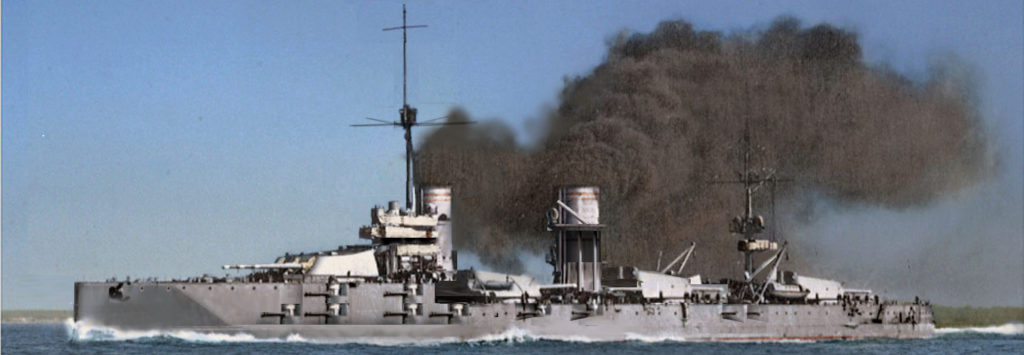
Photoshopping of the Gangut, showing what the Izmail could have look like in service, colorized by irotooko jr.
All four battlecruiser were officially laid down on 19 December 1912, work starting in March–April 1913. A progress review was published on 4 June 1914, but the launching of the first pair of ships was delayed until October and after August, it was assessed Izmail was 43% complete, while the others were lagging behind. Delays accumulated, first with the turbines ordered abroad, not delivered, and re-ordeded to the Franco-Russian works. Also the gun turrets resting on 203 mm (8 in) roller bearings made in Germany, but their replacements in United Kingdom and Sweden could not be obtained, no company willing or able to produce these. The new 14-in guns produced by Obukhof also had problems et were not delivered, leading to alternative proposals. There was also the competition for materials and men, diverted by more pressing needs, notably field guns production and small arms. Although Three ships were launched in 1915, completion was a long way forward. mostly because the turrets lacked many crucial parts, still non-delivered plus a general shortage of steel. The Russian Imperial administration eventually reclassed them as second rank projects while construction virtually stopped in 1916. Navarin was eventually launched the last, in November 1916, just to clear off the slipway. However there were still hopes to complete the Izmail, still waiting for its main turrets throughout 1916 and 1917.
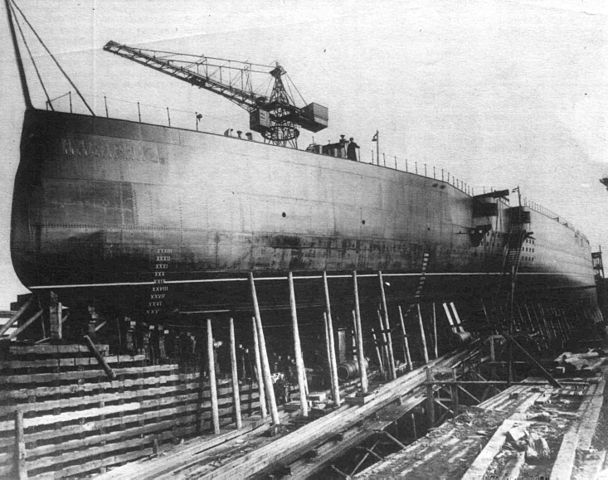
Incomplete hull of Navarin in Petrograd (ex Saint Petersburg). She was BU in Germany in 1922
Issues with the design
First off, the increased main armament stemmed from rumours about the same move in the German Navy, which probed false. It was probably the biggest issue as, together with armour scheme trials, it delayed the construction at its root, by having the blueprints completely modified to integrated an extra turret. In 1912 the fourth triple turret design was also paid in a drop of 1.5kts making the new design equal, and not superior in mobility to German battlecruisers. Emphasis standardisation of silhouette with the Gangut dreadnoughts was tried first but quickly revised for a raised forecastle to reach higher speed while preserving sea-keeping. The battlecruisers were even better armoured than the Gangut class, but this protection paled in comparison to German battlecruisers. Gangut class design issues, such as placing the 130 mm casemates directly below the heavy turrets was one crucial issue, as it repeated its shortcomings.
But overall, the Russians tried to expedite the construction of the new class by partly ordering turbines abroad, for the last pair, Navarin’s turbines from Vulkan and Kinburn’s ones from Parsons and of course after August 1914 they were never delivered. Consensus is they would have been delivered by the Franco-Russian Works like for the first pair, but both the shortage of materials and labour as Russia mobilized weighted heavily on the following program. The admiralty then took the decision to concentrate on the most advanced ship, Izmai, but only after June 1915. The three others were given low priority and work advanced slowly, although Borodino was launched just a few days after Izmail.
Also the development and introduction of the untested brand new 356 mm/52 Model 1912 guns from Obukhov Works was riddled with problems, and this, despite Vickers’ assistance in the process. This went so far as the admiralty suggested to the yards to replace the initial guns by well-proven 305 mm/52 (12 in) guns as delays to obtain the 356 mm pieces dragged on. Early in 1917, construction for all three battleship was stopped by order. Izmail however still had full priority and was scheduled for completion in early 1918. Of course the Bolshevik Revolution ruined these plans. It appeared that rearming the turrets, design for the new guns, for smaller 12-in would have cause more delays. There was also the solution of plating over part of the barbettes and install in shorter rings, turrets from the unfinished battleship Imperator Nikolai I, but that plan also would have cause delays.
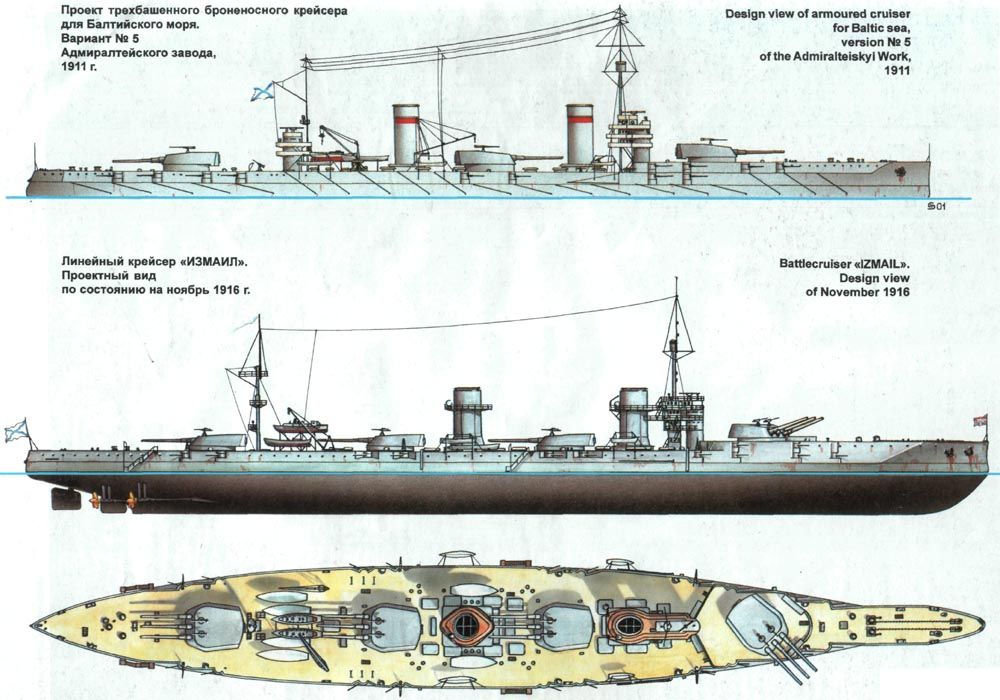
A two views of the Borodino class in 1916 (below) and the original design in 1911 (top)- Unknown src Russian book, from Pinterest
Projects and fate of the incomplete hulls
After the revolution, the new government was submitted a request by the new admiralty to complete the ships. Various plans were drafted by the General Staff and in coordonation with the Main Administration of Shipbuilding. One of these was to modify the turrets in order to authorize loading at a fixed angle of +4°. This would have made their completion much faster and simpler, although detrimental to the rate of fire. Another change planned was the lengthening of the funnels by 2 m (6 ft 7 in) for smoke interference, as seen on the Gangut-class already. Other proposals included a new modern powerplant, with geared turbines and a turbo-electric drive, or the brand new Föttinger’s hydraulic transmission.
The assessement of 28 April 1917 showed Izmail was the closest to completion, with her hull complete, engines and boilers in place and 65% complete, armour 36% complete. Turretsdelivery had now been delayed around 1919. The Congress of Shipyard Workers voted to continue working on the Izmail from mid-1917, mostly to provide jobs as there was no pressing defense at sea. The Provisional Government by 24 October 1917 confirmed this concentration by halting all remaining work for good on the ships, but later on 14 December 1917 the Bolsheviks decided the workers were needed elsewhere and cancelled the Izmail as well. The civil war was about to end and by October 1921, the Bolsheviks discussed about the fate of Izmail, and even possibly Borodino. They estimated that at least two years were necessary to built the turrets for the first battlecruiser only, and if only enough guns were available. So far, ten had been delivered by Vickers before the Revolution, while Obukhof tried to completed the rest from 1912. However the poor state of the immediate post-war Soviet heavy industry doomed this project. The commission also underlined the complexity of the electrical system and the lack of skilled engineers also meant it could not be completed under the current circumstances. The commission estimated a further delay of twenty months to replace this by a simpler system. However in a general way, there was some motivation to complete the ships: They were immensely superior to the Gangut class and due to their speed and perspectives of modernization, would have fare better against 1930s fast battleships of the time.
Projects for the last two battlecruisers
The Soviets discussed also finishing Kinburn and Navarin. They thought it cold be sensible to used their hull for a much modified design, featuring 410 mm (16 in) guns in two-gun turrets which could fit in the 14-in guns barbettes and weighed even slightly less. This was rejected because acquiring these guns from Vickers was unlikely. The Domestic manufacturing was also out of question due to the state of the industry at that point, and no other foreign manufacturers had that gun caliber “in store” on offer.
The commission after ruling out this plan, studies other conversions. One, a bit outlandish, was to convert the hulls into cargo ships or passenger liners. It was also discussed of a conversion into 22,000-long-ton (22,000 t) oil barges. But the size and shape of the hulls made them ill-suited for this. In the end, after all proposals were ruled out, the commission decided the best course of action was to just sell them at scrap metal value to Germany. They were sold for scrap on 21 August 1923, giving some well-needed currency to the government.
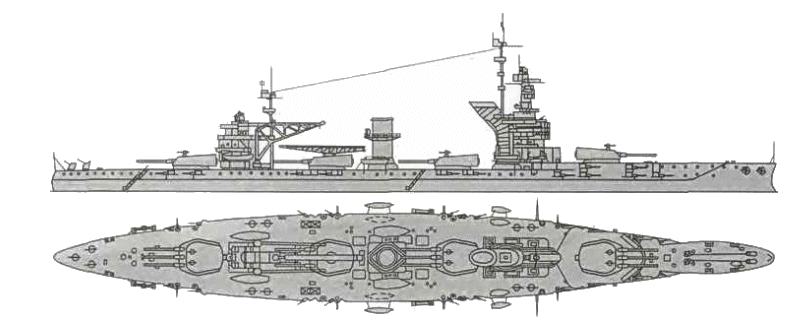
Izmail, whatif modernization proposal
Aircraft Carrier Izmail
In May 1925, Izmail was still available, her hull in laying in the Baltic Yard of Petrograd. The Administration of the Soviet Navy discussed another option, more in line with international naval developments than completing a 1911 battlecruiser design. Izmail was proposed to be converted as an aircraft carrier. Indeed, there was no shortage of examples of such conversions, framed by the treaty of Washington: The US Lexington class and the Japanese Kaga and Akagi were at that time in full reconversion. The experience of the Royal Navy showed this was not only possible, but potentially can bring new capabilities to the Navy. Some schematics were drawn around the hull, which was 230 m long, more than enough to carry a roomy landing deck.
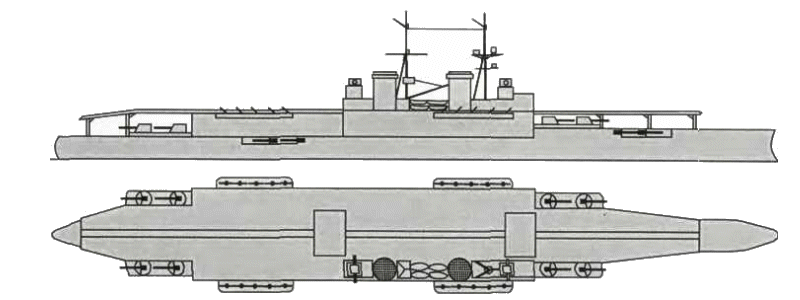
Izmail, alternative proposed Aircraft carrier (“aviamatka”)
As defined, specifications of the new carrier were a top speed of 27 knots (50 km/h; 31 mph), while the hangar carried up to 50 aircraft. The armament was also brand new, integrating eight 183-mm (7.2 in) guns in casemates, the new caliber designed for the Kirov class cruisers but also eight 102 mm guns in turrets. Armour protection was of course much reduced, down to 76 millimetres (3.0 in) for the belt. As shown by the reconstructed scheme, this was a kind of “hybrid” design typical of the time. There was little confidence to the aviation on board to defend the ship, so she was armed with the firepower equivalent of a cruiser, basically her potential escort. The guns were mounted in sponsons, in single turrets fore and aft, in tandem. In addition, eight 183 mm (7.2 in) casemate guns were kept, left in their original positions fore and aft, the forward pair being raised in the forecastle.
The flying deck was much shorted than the bow and also the stern, and narrow as the beam, but on either side for the sponson guns. The close hangar was also short, starting at the level of the island, about 1/3 from the prow. It was also stopped about 1/5 short of the stern. This would have made the accommodation of 50 planes unlikely, but only if using folding wings. The island itself was rather low, and long, and not built off-set to port but on the deck. There were two telemeters for the main artillery fore and aft of it and two tripod masts with projectors. The hangar was served by two lifts along this island. AA artillery was quite impressive for the time, presumably made of 37 mm guns, twenty in all, in four offset platforms fore and aft of the hull at flying deck level.
The “Tactical RKKF aircraft carrier had its speed set well above battleships, “so as to meet their special tasks the aircraft carrier will separate from the battleships and her condition is joining them in the shortest possible time“. The final air group, which looked more realistic, consisted of:
-12 torpedo bombers
-12 fighters
-6 Scouts and 5 artillery spotting planes.
No studies for modifying aircraft for carrier service was done, as the whole project was to be first validated.
The alternative protection included still 237 mm armor plates for the main belt, or leaving it to 76 mm, while the main flight deck was armored, at 51-64 mm armor as designed. This could have been the first carrier with an armoured flight deck, such as the British built at the end of the 1930s and the US in 1943.
Final design approximative displacement was around 20,000-22,000 tons, for a top speed of 27 knots. The schematic design of the NTK UMVS was approved on July 6, 1925.
This proposal was eventually approved by Alexey Rykov, Chairman of the Council of the People’s Commissars, on 6 July 1925. However the Red Armyat the time considered it was a costly naval project not in line with the supposed defensive stance of the Navy at that time. The Red army staff therefore strongly opposed and it, managing to block the project by gaining control of the commission reviewing the needs of the Navy in December 1925. The conversion project was cancelled on 16 March 1926 and the incomplete Izmail was scrapped from 1931 in Leningrad. This was not the last aircraft carrier project of the USSR, but certainly it was the first. The Russian navy however had some experience operating seaplane carriers during WWI.

A fictional rendition of Izmail, second of the Borodino class battlecruiser in WoW, as if modernized in WW2.
Specifications (1915) |
|
| Dimensions | 221 x 23.22 x 7.97m (725 ft x 76 ft 2 in x 26 ft 2 in) |
| Displacement | 32,500 long tons standard, 38,900 FL |
| Propulsion | 4 shafts Parsons turbines, 25 Yarrow boilers, 68,000 ihp |
| Speed | 26.5 knots (as designed) |
| Range | 1575 t coal, 150t oil, circa 8,000 nmi at 10 knots |
| Armament | 12 x 356mm/52 (14-in, 4×3), 24 x 130mm/55 (5.1-in), 8 x 75mm (3-in), 4 x 63mm AA, 4 MG, 6 x 533 mm TTs (21 in) |
| Armor | Waterline belt: 238–102 mm (9.5-4 in in), Decks: 63 mm (2.3 in), Turrets: 238 mm (9.7 in), CT: 10 in (254 mm) |
| Crew | 1,250 |
Sources
Conway’s all the world’ fighting ships 1906-1922
https://www.globalsecurity.org/military/world/russia/cb-izmail.htm
https://weaponsandwarfare.com/2016/10/10/borodino-class-battlecruisers/
Breyer, Siegfried (1992). Soviet Warship Development. Volume I: 1917–1937. London: Conway Maritime Press.
Friedman, Norman (2008). Naval Firepower: Battleship Guns and Gunnery in the Dreadnought Era.
Soviet Battleships 1933-1957 an illustrated technical reference
Friedman, Norman (2011). Naval Weapons of World War One. Barnsley, South Yorkshire, UK: Seaforth.
Gardiner, Robert & Gray, Randal, eds. (1985). Conway’s All the World’s Fighting Ships: 1906–1921.
McLaughlin, Stephen (2003). Russian & Soviet Battleships. Annapolis, Maryland: Naval Institute Press.
Silverstone, Paul H. (1984). Directory of the World’s Capital Ships. New York: Hippocrene Books.
Taras, Alexander (2000). Ships of the Imperial Russian Navy 1892–1917]. Library of Military History (in Russian).
Watts, Anthony (1990). The Imperial Russian Navy. London: Arms and Armour Press.
Crawford, Kent R. (1991). “Question 40/90”. Warship International. International Naval Research Organization. XXVIII
Haun, Claude; Ley, Michael P.; Morton, A. & Paist, Paul H. (1991). “Question 40/90”. Warship International. XXVIII
Model Kits:
-Zvezda 500789027 Model Cruiser Borodino 1:350
-Kniaz Suvorov 1/750 Eastern Express Kit review
-Combrig 1/700 Battlecruiser Izmail, 1917, resin kit
See also: http://steelnavy.com/CombrigIzmail.htm

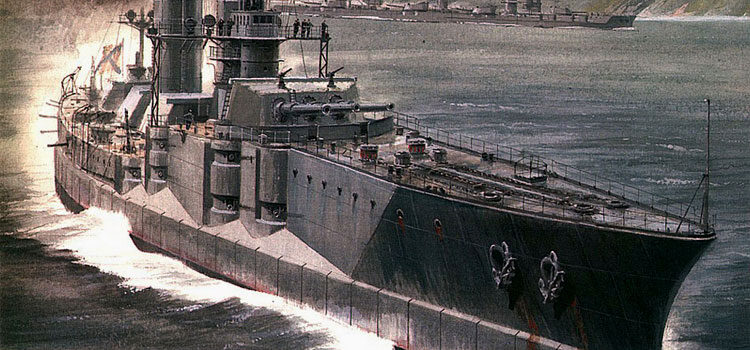

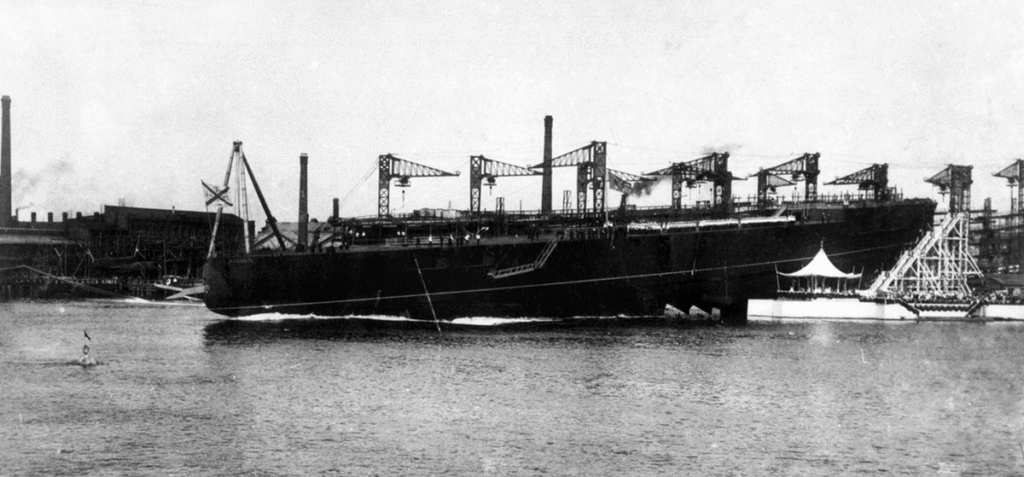
 Latest Facebook Entry -
Latest Facebook Entry -  X(Tweeter) Naval Encyclopedia's deck archive
X(Tweeter) Naval Encyclopedia's deck archive Instagram (@navalencyc)
Instagram (@navalencyc)





 French Navy
French Navy Royal Navy
Royal Navy Russian Navy
Russian Navy Armada Espanola
Armada Espanola Austrian Navy
Austrian Navy K.u.K. Kriegsmarine
K.u.K. Kriegsmarine Dansk Marine
Dansk Marine Nautiko Hellenon
Nautiko Hellenon Koninklije Marine 1870
Koninklije Marine 1870 Marinha do Brasil
Marinha do Brasil Osmanlı Donanması
Osmanlı Donanması Marina Do Peru
Marina Do Peru Marinha do Portugal
Marinha do Portugal Regia Marina 1870
Regia Marina 1870 Nihhon Kaigun 1870
Nihhon Kaigun 1870 Preußische Marine 1870
Preußische Marine 1870 Russkiy Flot 1870
Russkiy Flot 1870 Svenska marinen
Svenska marinen Søværnet
Søværnet Union Navy
Union Navy Confederate Navy
Confederate Navy Armada de Argentina
Armada de Argentina Imperial Chinese Navy
Imperial Chinese Navy Marinha do Portugal
Marinha do Portugal Mexico
Mexico Kaiserliche Marine
Kaiserliche Marine 1898 US Navy
1898 US Navy Sovietskiy Flot
Sovietskiy Flot Royal Canadian Navy
Royal Canadian Navy Royal Australian Navy
Royal Australian Navy RNZN Fleet
RNZN Fleet Chinese Navy 1937
Chinese Navy 1937 Kriegsmarine
Kriegsmarine Chilean Navy
Chilean Navy Danish Navy
Danish Navy Finnish Navy
Finnish Navy Hellenic Navy
Hellenic Navy Polish Navy
Polish Navy Romanian Navy
Romanian Navy Turkish Navy
Turkish Navy Royal Yugoslav Navy
Royal Yugoslav Navy Royal Thai Navy
Royal Thai Navy Minor Navies
Minor Navies Albania
Albania Austria
Austria Belgium
Belgium Columbia
Columbia Costa Rica
Costa Rica Cuba
Cuba Czechoslovakia
Czechoslovakia Dominican Republic
Dominican Republic Haiti
Haiti Hungary
Hungary Honduras
Honduras Estonia
Estonia Iceland
Iceland Eire
Eire Equador
Equador Iran
Iran Iraq
Iraq Latvia
Latvia Liberia
Liberia Lithuania
Lithuania Mandchukuo
Mandchukuo Morocco
Morocco Nicaragua
Nicaragua Persia
Persia San Salvador
San Salvador Sarawak
Sarawak Uruguay
Uruguay Venezuela
Venezuela Zanzibar
Zanzibar Warsaw Pact Navies
Warsaw Pact Navies Bulgaria
Bulgaria Hungary
Hungary

 Bundesmarine
Bundesmarine Dutch Navy
Dutch Navy Hellenic Navy
Hellenic Navy Marina Militare
Marina Militare Yugoslav Navy
Yugoslav Navy Chinese Navy
Chinese Navy Indian Navy
Indian Navy Indonesian Navy
Indonesian Navy JMSDF
JMSDF North Korean Navy
North Korean Navy Pakistani Navy
Pakistani Navy Philippines Navy
Philippines Navy ROKN
ROKN Rep. of Singapore Navy
Rep. of Singapore Navy Taiwanese Navy
Taiwanese Navy IDF Navy
IDF Navy Saudi Navy
Saudi Navy Royal New Zealand Navy
Royal New Zealand Navy Egyptian Navy
Egyptian Navy South African Navy
South African Navy






























 Ukrainian Navy
Ukrainian Navy dbodesign
dbodesign